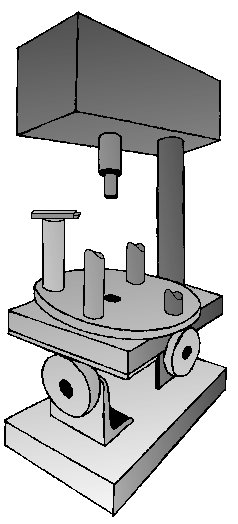| ||||
I remember from my Tech. Drawing days that it is possible to generate straight lines as a locus of a point when one disc is rotated upon another. Working with rotating discs removes all problems associated with backlash in linear slides so I suggest it is worth a thought or two.
The general arrangement is as shown. At its simplest, the table clamp is shimmed so when clamped tight it can still swing from side to side. An old faceplate is dropped into the table centre hole and located by some suitable bearing block under. A stepper motor mounting bracket is bolted to the underside of the table and a skateboard wheel (or similar) used to provide a friction drive. A second bracket (same design?) is bolted to the top of the base and brought to bear on a piece of plate bolted to the underside of the table.
Variations might include finding a ballrace big enough to slide over the column (perhaps with collets to space out differences in diameters) and a bearing block made which is bolted to the back of the drill table or some other slab of material.
Those wishing to go the distance could purpose design a simple casting to replace the whole drill table assembly. When used as a miller a small vice may be clamped to faceplate, work bolted straight on or double sided tape used if some suitable surface is fixed to the faceplate first. I understand the vertical tool travel is solved elsewhere.
Using this polar arrangement really comes into its own when operating in lathe mode. The workpiece is held in the drill chuck and brought down past the tool, which is fixed on a post to the faceplate. A number of tool posts can be set up and the faceplate simply rotated to present each one as required. Other functions become possible. If the work is held in the drill chuck but the motor not switched on, cutting spines, gears, flutes and keyways becomes possible! The table indexes round the workpiece as needed. As a finale it ought to be possible to not only move the tool in and out as the work rotates and moves past it but the tool can itself also move round the workpiece. This should lead to turning cams and other odd shapes. I am reminded of our industrial past when machines were invented to machine pulley blocks, rifle butts and barley sugar twist table legs! The engineering is simple enough and should be robust - it is all down to the maths to make it work! Anyone know a good mathematician? Still don't follow what's going on? Have a look at the simulation.Geoff Howard 26 February 2000 | ||||
 | ||||
| Project hosting kindly provided by |
|




